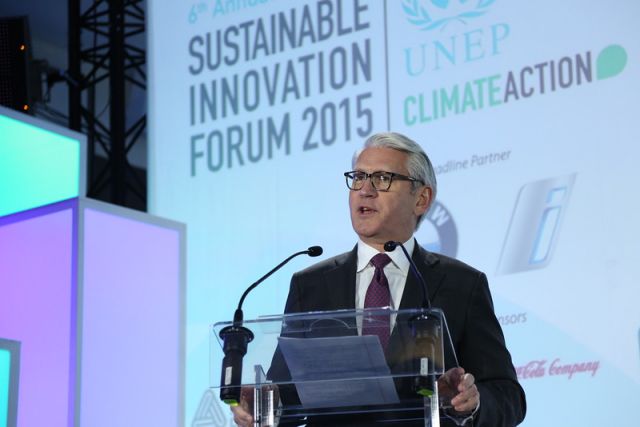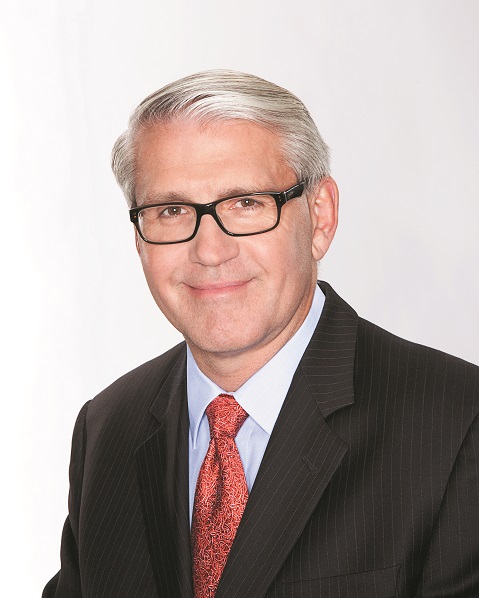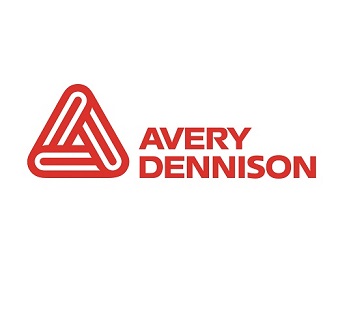Sustainable momentum at Avery Dennison
Climate Action spoke to Dean Scarborough, Chairman and CEO at Avery Dennison, about the company's approach to sustainability and the low-carbon solutions the company will be offering at COP21 in Paris in December

Climate Action spoke to Dean Scarborough, Chairman and CEO at Avery Dennison, about the company's approach to sustainability and the low-carbon solutions the company will be offering at COP21 in Paris in December.
Can you tell us about how Avery Dennison has been embracing sustainability?
Sustainability is integrated into our overall strategy, which is to provide sustainable momentum for all stakeholders, including shareholders, employees and the communities in which we work. It’s a strategy that reflects the realities of a world that’s warming, where raw materials are becoming more scarce and where companies are expected to be transparent in addressing their environmental and social responsibility.
Our commitment to sustainability stems from our founder, Stan Avery, who started our company because he believed a business could help far more people than any individual could ever do on his or her own. Now, 80 years later, we’re a multinational corporation with a presence in more than 100 communities, serving multiple industries. Our capacity to positively impact the communities in which our employees live and work has expanded to a degree that would probably even surprise Mr. Avery. Today, our rallying cry for sustainability is that we are a force for good embedded in industries and communities worldwide, challenging ourselves and others to reach higher and think bigger to improve the quality of all life.
Embracing sustainability at Avery Dennison means approaching it not just as something we do, but as a way of doing everything. It’s a way of thinking, seeing and acting. It’s good citizenship and good stewardship. It’s about being here for the long term, treating everyone with fairness and decency, and helping to protect and restore the earth’s natural systems and resources. Sustainability is how we meet our social, environmental and financial responsibilities. It’s how we innovate for customers, manage our supply chain, care for ouremployees, govern our business, contribute to communities and create value for our investors and for all of our stakeholders, today and well into the future.

We put formal sustainability governance in place in 2007 and publicly committed to our first sustainability goals in 2009 . Those goals expire this year, and by the end of 2015 we’ll have met or exceeded all of them. I’m proud of the work our teams across the globe have done to make those goals a reality.
We’re focused on the areas where we can make the most difference. Greenhouse gas emissions are a good example: our work is energy intensive, so we set an initial goal of reducing our emissions indexed to net sales by 15 per cent from 2005 levels. We’ll have done that by the end of this year. We’ve also reduced manufacturing waste we send to landfills to just 14 per cent of our total waste generated. We’ve worked hard to achieve a worldclass safety incident rate of 0.40. And we’ve tripled our philanthropic giving in emerging markets, particularly in Brazil, China and India. And as a large user of specialty paper, we know we can change the way our industry sources paper by implementing our responsible paper sourcing strategy.
We’ve also set additional objectives that, while not yet formal goals, are fundamentally shaping the way we do business. We’ve launched an initiative to increase the number of women in leadership positions companywide. Our Retail Branding and Information Solutions business, which serves the apparel industry, is using more recycled and certified materials. Our Materials Group, which makes pressuresensitive label stock and packaging, is getting almost a third of its paper from sources certified by the Forest Stewardship Council (FSC)—and we’ve set our sights much higher. This fall, we’ll announce an ambitious new set of sustainability goals that, over the next 10 years, will bring us closer to our vision of what a more sustainable Avery Dennison can be.
We create solutions that enable our customers, and their customers, to do business more sustainably
Given the many industries and brands our products are part of, we’re able to do much more to contribute to sustainability than just improve our own operations. We also create solutions that enable our customers, and their customers, to do business more sustainably. For example, we’ve created a label technology called CleanFlake TM , which makes more PET plastic bottles recyclable by enabling labels and adhesive to come off more readily during the recycling process. For our apparel customers, we’ve created RFID tags that don’t contain plastic, and we make all kinds of packaging and branding solutions that use recycled materials. And through our GreenPrint process, we routinely help some of the world’s biggest brands reduce the environmental footprint of their packaging and branding.
Avery Dennison has recently gotten some attention for its sustainably designed buildings. Can you tell us about those?
Our new European headquarters and our corporate headquarters both meet high bars for sustainability.
Our regional headquarters in The Netherlands is in a 13,000 square foot building we developed with the help of architect Paul de Ruiter. It was awarded a “Very Good” ratingunder BREEAM, a global programme for designing and assessing sustainable buildings. It has a number of features that reduce resource consumption along with operating costs. For example, the timber used in the building was FSC certified. We store surpluses of warm and cold air in the ground for later use. The elevator system actually recovers and uses the energy created by the cars moving up and down. Faucets are designed to save water, lighting ismotion controlled and the whole building is equipped with heatreflective glass, which means lower temperature and less need for air conditioning. We’ve even got a vegetation covered green roof, complete with birdhouses. It’s really quite a place.
Our corporate headquarters in California is certified LEED Gold, the highest level attainable through the U.S. Green Building Council’s certification programme
Our corporate headquarters in Glendale, California, is housed in several leased floors of a building certified LEED Gold, the highest level attainable through the U.S. Green Building Council’s certification programme. Our offices feature lowflow water fixtures, materials made from recycled content (that are often recyclable themselves), sensors that control interior lighting based on the availability of natural light, lowor noVOC finishes and more. The building was designed to meet the State of California’s energyefficiency requirements, which
are stricter than those under LEED.
I should also point out that, in addition to being designed to operate more sustainably, both spaces are also laid out with open floorplans that are enabling much more crossfunctional collaboration. And our building in Europe has a large “experience center” in the firstfloor atrium where our customers can see, touch and learn about our products. So along with being sustainable, both buildings are supporting the growth of our business in other ways as well.
You recently visited Honduras with Rainforest Alliance. What was the purpose of that trip?
I was part of a team from Avery Dennison that went down to see how work was progressing under a three-year $600,000 grant that our Avery Dennison Foundation is providing to Rainforest Alliance to help stop deforestation in Honduras and promote businesses related to sustainable forestry. The work we’re supporting is being done in the heavily forested northeast corner of the country, in a place sometimes called the Little Amazon because of its dense forests and biodiversity.
The project we’re supporting has already created 190 new jobs, $560,000 in sales of sustainably produced wood products and 40,000 hectares of FSC certified forest
We spent several days meeting with our friends from Rainforest Alliance as well as people from local communities. We visited towns where we talked with residents and saw howforestry cooperatives, which manage some of the world’s most precious timber stocks, are learning to harvest and process trees more sustainably. The project we’re supporting has already created 190 new jobs, $560,000 in sales of sustainably produced wood products and 40,000 hectares of FSC certified forest. And it’s on track to achieve outcomes several times those by the end of 2017.
We also saw some of the obstacles that people there are facing. There’s a lack of basic infrastructure, like reliable electric power. There’s a shortage of safety expertise and equipment. There are regular threats of violence from illegal loggers and drug traffickers. And local markets for sustainable wood products are virtually nonexistent. So this spectacular, resourcerich place with the most biodiversity in Central America also has some of the worst poverty.
There’s a lot I’ll remember about that trip, but the biggest takeaway for me was how quickly we began to develop solutions when we had all the players there on the ground, together—our company, Rainforest Alliance, local residents and community leaders. We automatically started brainstorming ideas for how to tackle some of the biggest issues. Just as one example, we agreed to have some of our employees in Honduras help a cooperative operate more safely and productively by providing guidance on electrical work and maintenance for their carpentry workshop. For me, the experience really drove home how creating sustainability requires close collaboration among all parts of society—business, government, nonprofits and local citizens.
Avery Dennison CleanFlake won the FTA’s Environmental Excellence Award for Innovations in Sustainability. Can you expand on that?
CleanFlake is a great example of how we can have a much bigger impact on sustainability by offering innovative solutions to our customers. It’s a label solution that makes bottles made from polyethylene terephthalate, or “PET plastic,” more recyclable. PET plastic is really resource intensive. Using recycled PET plastic instead of brandnew material saves huge amounts of water, petroleum and carbon emissions. But despite that, and despite decent recycling rates worldwide, most PET plastic bottles are still made from virgin material, not recycled. And one big reason is that the pressure-sensitive labels found on most PET bottles are a barrier to the recycling process. The adhesive doesn’t come off easily, so fragments of label and residual adhesive contaminate the “flake” produced when PET plastic is reclaimed. As a result, most PET plastic is downcycled into products other than new beverage bottles. And tens of millions of tons of PET plastic doesn’t even get recycled—it’s lost from the process because of contamination.
We can have a much bigger impact on sustainability by offering innovative solutions to our customers
CleanFlake solves the labelcontamination problem by combining a thin, light label with a waterbased adhesive that’s “switchable”—which means it sticks to the bottle until its cohesive bond is broken during the bath that’s part of the recycling process. When that bond breaks, the label separates cleanly from the bottle, leaving behind no residue or other contaminants. The bottles can then be ground into flake and used to make new foodgrade bottles.
How is the company minimising greenhouse gas emissions from its supply chain?
So far, our work to minimise greenhouse gas emissions has focused on our own operations. We’re committed to doing our part and reducing greenhouse gasses, even as our overall production grows. We’ve had good initial success, and we’ll be substantially raising the bar for ourselves when we announce our new goals later this year. Holding our suppliers to our
standards for energy use and greenhouse gas emissions, and helping them meet them, is something we intend to do and will move toward this year, with rapidly increasing momentum in the years to come.
At COP21 in Paris this year, governments are due to agree to a landmark new global binding climate deal to limit greenhouse gas emissions and boost climate finance. What opportunities could this present to Avery Dennison?
As our customers seek to reduce their Scope 3 emissions from purchased materials, we’ll be there to help by offering lesscarbonintensive solutions. But a new global climate agreement could also provide something even more important: the opportunity for our 80 year-old company to still be doing business 80 years from now. Like every business, we rely on a healthy planet and a stable ecosystem. Those things underpin not just business but entire economies.
Negotiators have the chance to make Paris a historic turning point
Climate change is a threat to our supply chain, to our customers’ businesses and, of course, to the communities where we live and work. Negotiators have the chance to make Paris a historic turning point by agreeing to maintain emissions at the levels science says are necessary to keep global warming below 2 degrees Celsius and avoid the worst effects of climate change. We very much hope they will.






